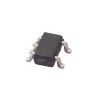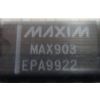DescriptionThe MAX9880A's stereo differential microphone inputs can support either analog or digital microphones. A stereo single-ended line input, with a configurable preamplifier, can either be recorded by the ADC or routed directly to the headphone or line output amplifiers. The stereo headphone amplifiers can be configured as differential, single ended, or capacitorless. The stereo line outputs have dedicated level adjustment. The MAX9880A can be combined with an audio subsystem, such as the MAX9877 or MAX9879, for a complete audio solution for portable applications. The MAX9880A is a high-performance, stereo audio codec designed for portable consumer applications such as smartphones and tablets. Operating from a single 1.8V supply to ensure low-power consumption, the MAX9880A offers a variety of input and output configurations for design flexibility. The MAX9880A prevents click and pop during volume changes and during power-up and power-down. Audio quality is further enhanced with user-configurable digital filters for voice and audio data. Voiceband filters provide extra attenuation at the GSM packet frequency and greater than 70dB stopband attenuation at fS/2. An I2C or SPIserial interface provides control for volume levels, signal mixing, and general operating modes. There are two digital audio interfaces. The primary interface is intended for voiceband applications, while the secondary interface can be used for high performance stereo audio data. Two digital input streams can be processed simultaneously and both digital interfaces support TDM and I2S data formats. The MAX9880A is available in space-saving, 48-bump, 2.7mm x 3.5mm, 0.4mm-pitch WLP and 48-pin, 6mm x 6mm TQFN packages. The flexible clocking circuitry utilizes any available 10MHz to 60MHz system clock, eliminating the need for an external PLL and multiple crystal oscillators. Both the ADC and DAC can be operated synchronously or asynchronously in master or slave mode. The ADC can be operated from 8kHz to 48kHz sample rates, while the DAC can be operated up to 96kHz.
The features of MAX9880A can be summarized as (1)1.8V Single-supply operation; (2)10.6mW playback power consumption; (3)8kHz to 96kHz stereo DAC with 96dB dynamic range; (4)8kHz to 48kHz stereo ADC with 82dB dynamic range; (5)support for any master clock between 10MHz to 60MHz; (6)stereo microphone inputs support digital microphones; (7)stereo headphone amplifiers: differential (30mW), single-ended, or capacitorless (10mW); (8)stereo line inputs and stereo line outputs; (9)voiceband filters with stopband attenuation greater than 70dB; (10)battery-measurement auxiliary ADC; (11)comprehensive headset detection; (12)Dual I2Sand TDM-compatible digital audio interfaces; (13)I2Cor SPI-compatible control bus with 3.6V tolerant inputs.
The absolute maximum ratings of MAX9880A are (1)DVDD, AVDD and PVDD: -0.3V to +2V; (2)DVDDS1, JACKSNS, MICVDD: -0.3V to +3.6V; (3)DGND and PGND:-0.1V to +0.1V; (4)PREG, REF, REG: -0.3V to (VAVDD + 0.3V); (5)MICBIAS: -0.3V to (VMICVDD + 0.3V); (6)MCLK, LRCLKS1, BCLKS1, SDINS1, SDOUTS1:-0.3V to (VDVDDS1 + 0.3V); (7)X1, X2, LRCLKS2, BCLKS2, SDINS2, SDOUTS2, DOUT, MODE: -0.3V to (VDVDD + 0.3V); (8)SDA/DIN, SCL/SCLK, CS, IRQ: -0.3V to +3.6V; (9)LOUTP, LOUTN, ROUTP, ROUTN, LOUTL, LOUTR: (VPGND 0.3V)to (VPVDD + 0.3V); (10)LINL, LINR, MICLP/DIGMICDATA, MICLN/DIGMICCLK, MICRP/SPDMDATA, MICRN/SPDMCLK: -0.3V to (VAVDD + 0.3V); (11)continuous power dissipation (TA = +70°C)48-bump WLP (derate 12.5mW/°C above +70°C): 1000mW / 48-Pin TQFN (derate 37mW/°C above +70°C): 2963mW; (12)junction-to-ambient thermal resistance (JA)48-bump WLP: 80°C/W / 48-pin TQFN:29°C/W; (13)junction temperature: +150°C; (14)operating temperature range: -40°C to +85°C; (15)storage temperature range: -65°C to +150°C; (16)lead temperature (soldering, 10s): +300°C; (17)soldering temperature (reflow): +260°C.

 MAX9880A Data Sheet
MAX9880A Data Sheet







